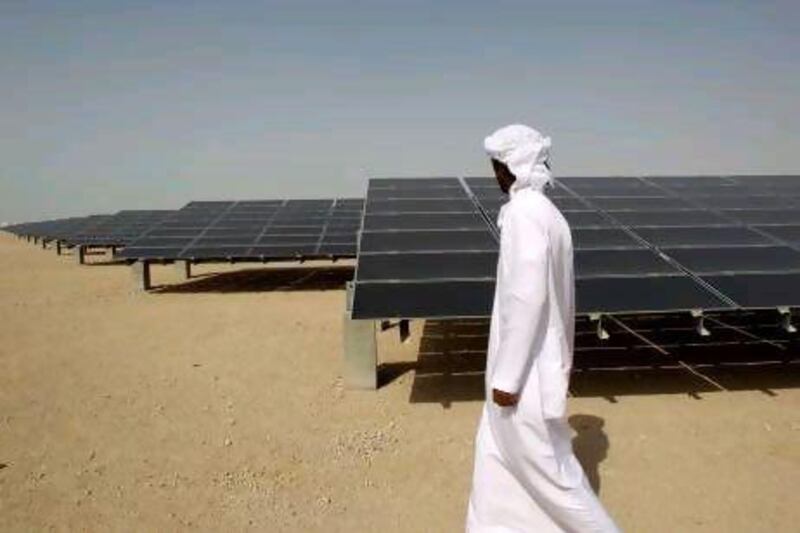ABU DHABI // An organisation with the impressive title of the World Future Council (WFC) arrives in Abu Dhabi later this week. Set up by a Swedish green activist in 2007, the WFC is centred around a 50-strong council of what it calls "respected personalities", including the primatologist Jane Goodall and the activist actress Daryl Hannah. And at its first annual general meeting to be held in the Middle East, the WFC is pondering the issue of "Securing our world: the crucial next five years".
Cynics might say that, with our planet already threatened by global warming, the last thing it needs is another source of hot air. Still, in choosing Abu Dhabi as the location of its conference, the WFC clearly knows where the action is on sustainability.
Delegates will be able to visit Masdar City, the UAE's US$18 billion (Dh66.1bn) flagship of sustainable urban living. The project will give glimpses of what is possible in urban development within the next few years.
There are valuable lessons to be learned for those who do visit Masdar, beyond those that are more usually advertised. Chief among them is that anyone wanting to save the planet faces big challenges: knowing which technology to back, and which to leave alone.
Hardly a week goes by without some team of scientists announcing a breakthrough that promises to transform our world. Last month, a small British company made international headlines by claiming to have made petrol from fresh air. Air Fuel Synthesis said it had succeeded in making a few litres of petrol using water vapour and carbon dioxide from the atmosphere, and planned to scale up to commercial production within the next two years.
This was a rare case of a story that experts found less amazing than the general public. As scientists were quick to point out, the idea of taking these two ubiquitous ingredients and turning them into fuel is an old story - about 3.4 billion years old, to be precise. That's how long photosynthesis has been around, allowing plants to convert the energy of sunlight into a chemical source of energy.
As such, many of us have technology capable of pulling off the basic trick behind the Air Fuel Synthesis story sitting in pots at home. What left the experts cold was the suggestion that the fuel-from-air idea could ever be made commercially viable. The process needs electrical energy, though admittedly this could come from renewable sources. Then there is the conversion into a liquid fuel, which makes the economic case even weaker.
So this is clearly one planet-saving technology we can forget about. Or is it? One should never underestimate the ability of engineers to turn trickles into torrents.
At the start of the 20th century, the biggest fear was that the world would not be able to feed itself. Then the brilliant German chemist Fritz Haber came up with a way of capturing the virtually limitless nitrogen in the atmosphere, and turning it into a form suitable for fertiliser, thus transforming crop yields. But his first experiments in 1909 succeeded in producing barely a cupful of the stuff per hour.
Fortunately, he teamed up with Carl Bosch of BASF, a chemical engineer, and within a few years they had scaled up production by a factor of 10,000. Today, global production is at a rate 10,000 times greater again. Suddenly those few litres of petrol produced by a small company in the north of England don't seem so laughable.
That still leaves the question of economics, of course, and it would be a brave person who invests in the fuel-from-air technique expecting a return any time soon. Better to stick to the old ways of saving the planet.
Yet, even here, there are challenges facing those keen to do the right thing. One of the cornerstones of sustainability is energy conservation - and small wonder, given its simplicity. But scientists are discovering that manifesting its benefits is harder than it seems.
Official campaigns to get people to use less energy notoriously produce much lower savings than expected. For some reason, computer models of low-energy homes seem to overestimate just how energy efficient they will be.
Various explanations have been put forward, but researchers at the University of Cambridge now think the cause lies in what people do in the comfort of their homes. And the suspicion is that people are always trying to make themselves even more comfortable.
Analysing energy use in thousands of homes across Europe, the researchers found that people living in low-energy homes exploit that fact by turning up the heat in winter, rather than by saving money on fuel. As a result, the reduction in their annual energy consumption is much less than expected.
This is an echo of an effect noted by psychologists studying other issues like road safety. The introduction of measures such as seat belts produces a smaller improvement in casualty figures than expected, because drivers feel more secure - and thus drive more dangerously.
But the energy-use data has revealed a second reason for the gap between theory and reality in energy conservation. Those living in old buildings with poor energy efficiency try to avoid hefty fuel bills by saving energy whenever possible. This again confounds the computer predictions - this time by producing lower-than-expected benefits from upgrading to better housing. Combined with what happens in low-energy buildings, this ensures that projected savings from upgrading buildings are much lower than expected.
As they tour the work-in-progress that is Masdar City, the respected personalities of the World Future Council will see much to inspire them. But they should brace themselves for the reality that even the simplest ways of saving the planet can prove anything but.
- Robert Matthews is visiting reader in science at Aston University, Birmingham, England






